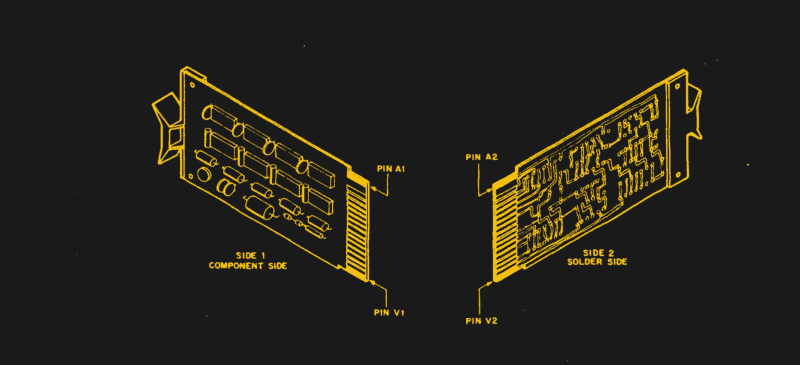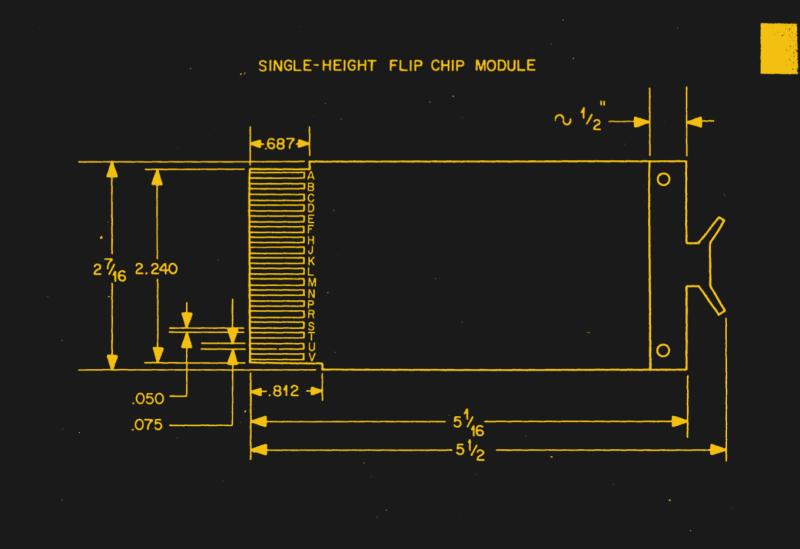We like retro-computing and we like open source standards that allow easy project sharing. Vintage DEC computer enthusiast [Jay Logue] combines both of these in his recent project on GitHub, where he shares several KiCad templates for making your own Flip-Chip modules. Although named after the semiconductor packaging technique we are familiar with today, DEC Flip-Chips were introduced in 1964 as a modular electronics packaging system. These were used in many of DEC’s Programmable Data Processor (PDP) computers, beginning with the PDP-8 in 1965. DEC also had a Digital Laboratory Module family, which was a roll-your-own custom electronic system. The 1968 Digital Logic Handbook shows the available modules, and has the look and feel of the TTL Cookbook book which would come along six years later.

Flip-Chips came in a variety of sizes over the years: single-, double-, and quad-, and hex-height boards having standard- and extended-length. The PCB’s have 18 gold-plated fingers on one edge, later extended to 36 fingers double-sided, which plug into a backplane. Interconnections were typically wire-wrapped. A single height board is 127 x 62 mm (5 x 2-7/16 inches) with a labeled extractor bracket on one end. [Jay]’s repository has templates for five of the most popular variations, and making other sizes should be straightforward using these templates as a starting point.

While we pack a lot more functionality in similarly-sized circuit boards these days, many systems still use a modular design not unlike the Flip-Chips from over 50 years ago. Do you have any recollections of using Flip-Chips, or are you using them today? Let us know in the comments below.
















Back in the late ’60s / early ’80s, I had discovered IBM module connectors on Canal Street [NYC], and standardized my boards [hand etched] using that format. I end drilled some1/4 rods to use as un & wrapping tools and found that the wire in multi-conductor telephone cable was perfect for wire wrapping the rectangular pins.Discrete transistor gates & flip-flops using 2N404s
What you are talking is not a “Flip-Chip”, which is a modern semiconductor mounting construct.[1] To avoid confusion, I suggest you talk about the vintage DEC PDP “Flip-Chip Module”.[2] Or ignore me – I’m a Pedant.
* References:
1. Flip Chip
https://en.wikipedia.org/wiki/Flip_chip
2. Flip Chip (PDP Module)
https://en.wikipedia.org/wiki/Flip_Chip_(PDP_module)
Thanks !
The trademark expiration line on WP was helpful.
I second that the title is misleading and should begin with “DEC”, as revealed in the middle of the paragraph:
> Although named after the semiconductor packaging technique we are familiar with today, DEC Flip-Chips were introduced in 1964 as a modular electronics packaging system.
Point noted. Not quite so modern, depending on your point of reference — DEC’s original flip chip modules were made using flip chip packaged semiconductors.
@Chris Lott said: “Point noted. Not quite so modern, depending on your point of reference — DEC’s original flip chip modules were made using flip chip packaged semiconductors.”
Hi Chris – You may be right. I see some references to “flip chips” in DIP ceramic packages that are rather thick in the Z dimension. Is this what you are referring to? Example:
https://www.memory4less.com/digital-equipment-chipset-and-ic-g727a
The most common “flip chip” used by DEC back in the day resembled a small SMT PCB encased in potting compound and turned on edge to solder the leads into the PCB. A photo of the result can be seen in this photo:
http://svn.so-much-stuff.com/svn/trunk/Eagle/projects/DEC/Rxxx/R111/R111Efront.jpg
The actual function is a pull-up and set of diodes forward biased to form a -3V reference. The equivalent circuit can be seen here:
http://svn.so-much-stuff.com/svn/trunk/Eagle/projects/DEC/Rxxx/R111/R111Ffront.jpg
If you look closely, you’ll see that is possible to populate either etch with discretes, or with a flip chip. This is because the technology was so unreliable (read: expensive to make), that the discrete components were often preferable from a manufacturability viewpoint.
Vince
Yes Chris Lott is right there are many semi conductors that has taken the place of Flip Chip just like SSD (Solid State drive) https://www.allhdd.com/samsung-mzplj1t6hbjr-00007-ssd/
These drive are also a form of semi conductor and used widely these days.
Congrats and thanks for the great work, Jay!
If you can stand the “old guy stink” of SVN and Eagle, there are over a dozen years worth of DEC “flipchip” and related drawings here: https://so-much-stuff.com/pdp8/cad/cad.php
The dec-con library most resembles your work. The “flipchip” drawings are down in the board table with names like DEC/Mxxx/M113/…
Vince
Thank you, Vincent! I have perused your wonderful PDP-8 site on a number of occasions, but I had never made it into the CAD section. (And being a rank amateur at PCB design, with no experience using Eagle, I undoubtedly wouldn’t have known what I was looking at anyway).
I imagine there are plenty of people who prefer using Eagle to KiCAD. So I’ve updated the README on my project page to include a pointer to your site. Hopefully this will encourage someone to start some interesting new project for these fascinating old machines!
— Jay
Thanks!
You might find one of these pages more useful, if you are specifically looking for flip chip modules:
https://so-much-stuff.com/pdp8/flipchip/flipchip.php
https://so-much-stuff.com/pdp8/flipchip/modules.htm
For PDP-11 related modules, this might be an interesting sub-page:
https://so-much-stuff.com/pdp8/flipchip/Mxxx.htm
You used to be able to load up any of the drawings in the free version of Eagle, look at them, print them, and even emit Gerbers. (I haven’t kept up with the current Eagle downloads since the licensing went wonky.) You just couldn’t change them outside the licensed window (4×6 inches or so I think it was for the free version).
I also believe KiCad can import the drawings, though that sometimes seemed to give minor errors last time I tried it.
Back in the day, Eagle was the bee’s knees. Now, I’d be using KiCad, except that there are so many drawings that it would take months to convert them all. (Took me nearly two months to convert from Eagle 4 to Eagle 6/7 back when I did that.)
Vince
[Template author here…]
Thanks for the article, Chris. I can report that the templates worked perfectly as the basis for my M9042 Clone project (https://github.com/jaylogue/m9042-clone), which has allowed me to expand my lowly slim-box PDP-11/05 to a whopping 48KB of core memory. (Only 8KB more to go and I can run MiniUnix!)
— Jay
I am still confused with flip chips. This is a new topic for me. Does Filp chip looks something like that https://www.allhdd.com/hp-700136-b21/?